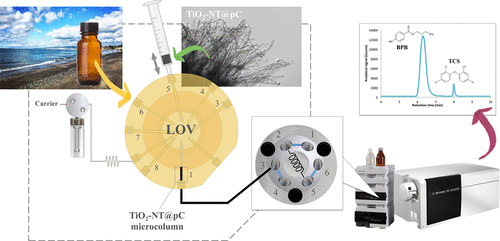当前位置:
X-MOL 学术
›
Anal. Chem.
›
论文详情
Our official English website, www.x-mol.net, welcomes your
feedback! (Note: you will need to create a separate account there.)
Lab-on-a-Valve Mesofluidic Platform for On-Chip Handling of Carbon-Coated Titanium Dioxide Nanotubes in a Disposable Microsolid Phase-Extraction Mode
Analytical Chemistry ( IF 6.7 ) Pub Date : 2018-03-01 00:00:00 , DOI: 10.1021/acs.analchem.8b00158 María Teresa García-Valverde 1 , María Rosende 2 , Rafael Lucena 1 , Soledad Cárdenas 1 , Manuel Miró 2
Analytical Chemistry ( IF 6.7 ) Pub Date : 2018-03-01 00:00:00 , DOI: 10.1021/acs.analchem.8b00158 María Teresa García-Valverde 1 , María Rosende 2 , Rafael Lucena 1 , Soledad Cárdenas 1 , Manuel Miró 2
Affiliation

|
Mesofluidic lab-on-a-valve (LOV) platforms have been proven suitable to accommodate automatic micro-solid-phase extraction (μSPE) approaches with on-chip handling of micrometer-bead materials in a fully disposable mode to prevent sample cross-contamination and pressure-drop effects. The efficiency of the extraction process notably depends upon the sorptive capacity of the material because the sorbent mass is usually down to 10 mg in LOV devices. Nanomaterials, capitalizing upon their enhanced surface-to-volume ratio and diversity of potential chemical moieties, are appealing alternatives to microbead sorbents. However, the handling and confinement of nanomaterials in fluidic chip structures have been challenging to date. This is most likely a consequence of the aggregation tendency of a number of nanomaterials, including carbon-based sorbents, that leads to excessive back-pressure in flowing systems along with irreproducible bead loading. This paper addresses these challenges by ad hoc synthesis of hybrid nanomaterials, such as porous carbon-coated titanium dioxide nanotubes (TiO2–[email protected]). Tailoring of the surface polarity of the carbon coating is proven to foster the dispersion of TiO2–[email protected] in LOV settings while affording superior extraction capability of moderately nonpolar species from aqueous matrices. The determination of trace-level concentrations of butylparaben (BPB) and triclosan (TCS) in seawater samples is herein selected as a proof-of-concept of the exploitation of disposable nanomaterials in LOV. The mesofluidic platform accommodating μSPE features online hyphenation to liquid chromatography/tandem mass spectrometry (LC/MS/MS) for reliable determination of the target analytes with excellent limits of detection (0.5 and 0.6 ng/L for BPB and TCS, respectively) and intermediate precision (relative standard deviation <5.8%). For 5.0 mL of sample and 200 μL of eluent, enrichment factors of 23 and 14 with absolute extraction efficiencies of 90% ± 14% and 58 ± 8% for BPB and TCS, respectively, were obtained. The relative recovery values of 107% (BPB) and 97% (TCS) in seawater demonstrate the applicability of online LOV-LC/MS/MS using TiO2–[email protected] for handling troublesome environmental samples.
中文翻译:

用于一次性微固相萃取模式中碳包覆二氧化钛纳米管的片上处理的气门实验室中流平台
中流阀实验室(LOV)平台已被证明适用于自动微固相萃取(μSPE)方法,并以完全一次性的方式在芯片上处理微米珠子材料,以防止样品交叉污染和压降效应。萃取过程的效率特别取决于材料的吸附能力,因为在LOV装置中吸附剂质量通常降至10 mg。纳米材料利用其增强的表面体积比和潜在化学部分的多样性,是微珠吸附剂的有吸引力的替代品。然而,迄今为止,在流体芯片结构中纳米材料的处理和限制一直是挑战性的。这很可能是许多纳米材料(包括碳基吸附剂)聚集趋势的结果,这会导致流动系统中过高的背压以及不可复制的珠粒载荷。本文通过杂化纳米材料的临时合成解决了这些挑战,例如多孔碳包覆的二氧化钛纳米管(TiO2 – [电子邮件保护])。事实证明,定制碳涂层的表面极性可促进TiO 2的分散–在LOV设置中受[电子邮件保护],同时具有从水性基质中提取中等极性物质的出色能力。本文选择测定海水样品中对羟基苯甲酸丁酯(BPB)和三氯生(TCS)的痕量浓度作为LOV中一次性纳米材料开发的概念验证。容纳μSPE的中流平台具有液相色谱/串联质谱(LC / MS / MS)在线联用功能,可可靠地测定目标分析物,同时具有出色的检测限(分别为BPB和TCS分别为0.5和0.6 ng / L)和中间产物精度(相对标准偏差<5.8%)。对于5.0 mL样品和200μL洗脱液,获得的富集系数分别为23和14,而BPB和TCS的绝对提取效率分别为90%±14%和58±8%。2 – [电子邮件保护],用于处理麻烦的环境样本。
更新日期:2018-03-01
中文翻译:

用于一次性微固相萃取模式中碳包覆二氧化钛纳米管的片上处理的气门实验室中流平台
中流阀实验室(LOV)平台已被证明适用于自动微固相萃取(μSPE)方法,并以完全一次性的方式在芯片上处理微米珠子材料,以防止样品交叉污染和压降效应。萃取过程的效率特别取决于材料的吸附能力,因为在LOV装置中吸附剂质量通常降至10 mg。纳米材料利用其增强的表面体积比和潜在化学部分的多样性,是微珠吸附剂的有吸引力的替代品。然而,迄今为止,在流体芯片结构中纳米材料的处理和限制一直是挑战性的。这很可能是许多纳米材料(包括碳基吸附剂)聚集趋势的结果,这会导致流动系统中过高的背压以及不可复制的珠粒载荷。本文通过杂化纳米材料的临时合成解决了这些挑战,例如多孔碳包覆的二氧化钛纳米管(TiO2 – [电子邮件保护])。事实证明,定制碳涂层的表面极性可促进TiO 2的分散–在LOV设置中受[电子邮件保护],同时具有从水性基质中提取中等极性物质的出色能力。本文选择测定海水样品中对羟基苯甲酸丁酯(BPB)和三氯生(TCS)的痕量浓度作为LOV中一次性纳米材料开发的概念验证。容纳μSPE的中流平台具有液相色谱/串联质谱(LC / MS / MS)在线联用功能,可可靠地测定目标分析物,同时具有出色的检测限(分别为BPB和TCS分别为0.5和0.6 ng / L)和中间产物精度(相对标准偏差<5.8%)。对于5.0 mL样品和200μL洗脱液,获得的富集系数分别为23和14,而BPB和TCS的绝对提取效率分别为90%±14%和58±8%。2 – [电子邮件保护],用于处理麻烦的环境样本。











































 京公网安备 11010802027423号
京公网安备 11010802027423号